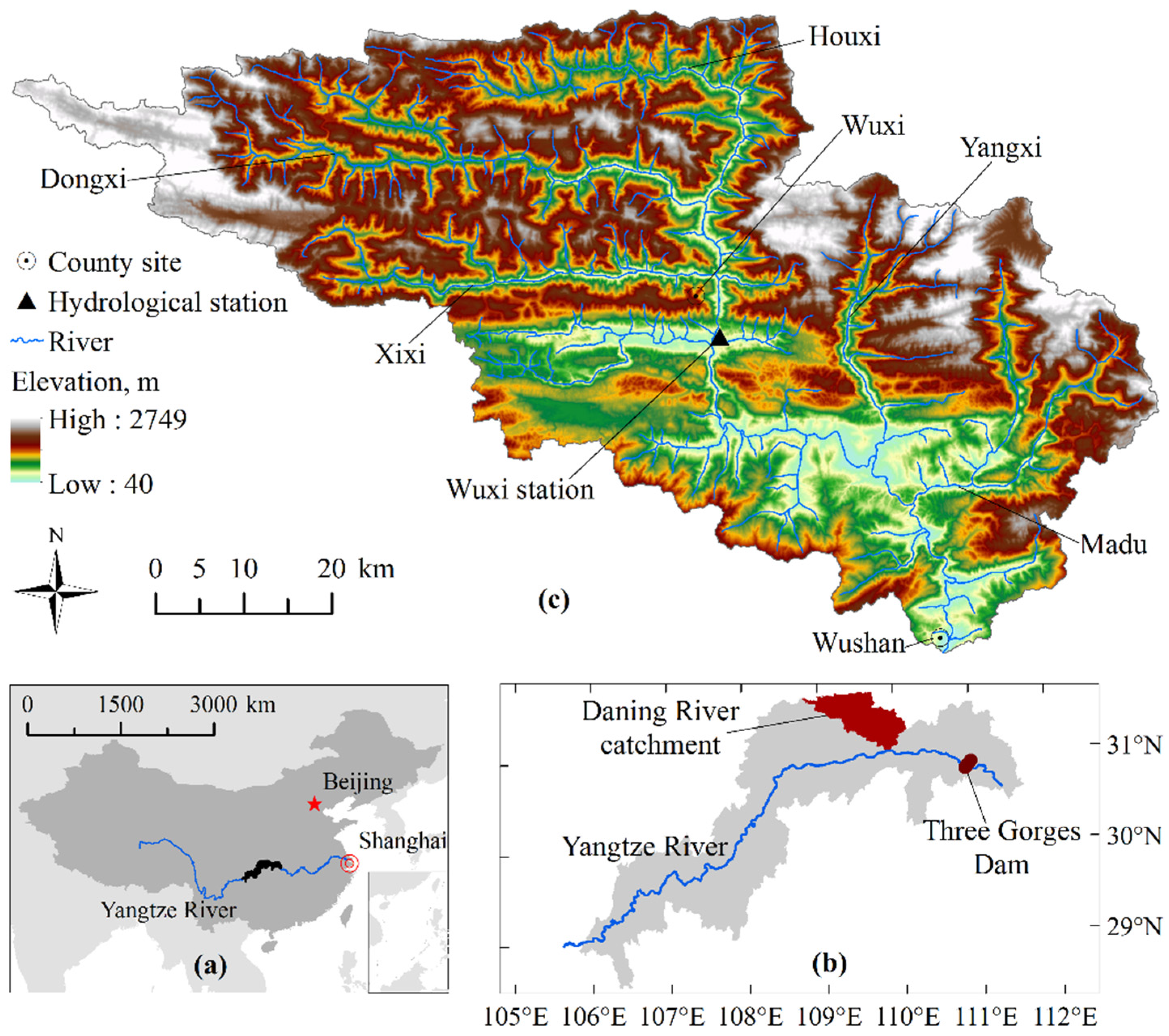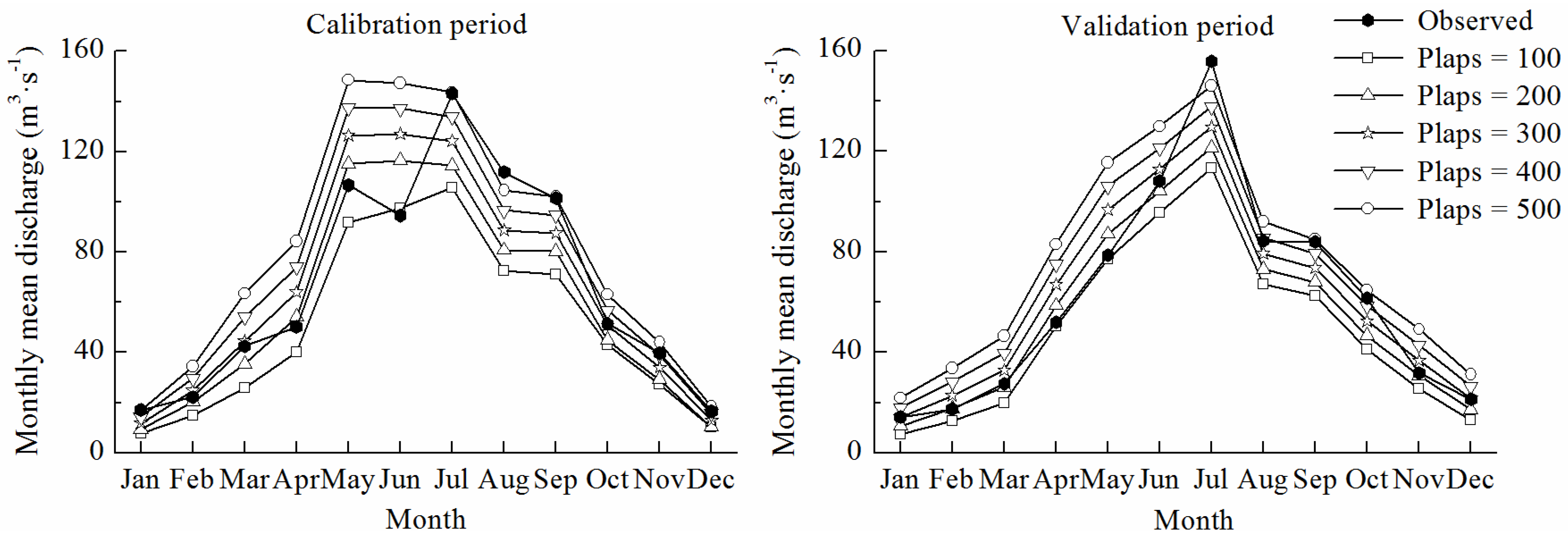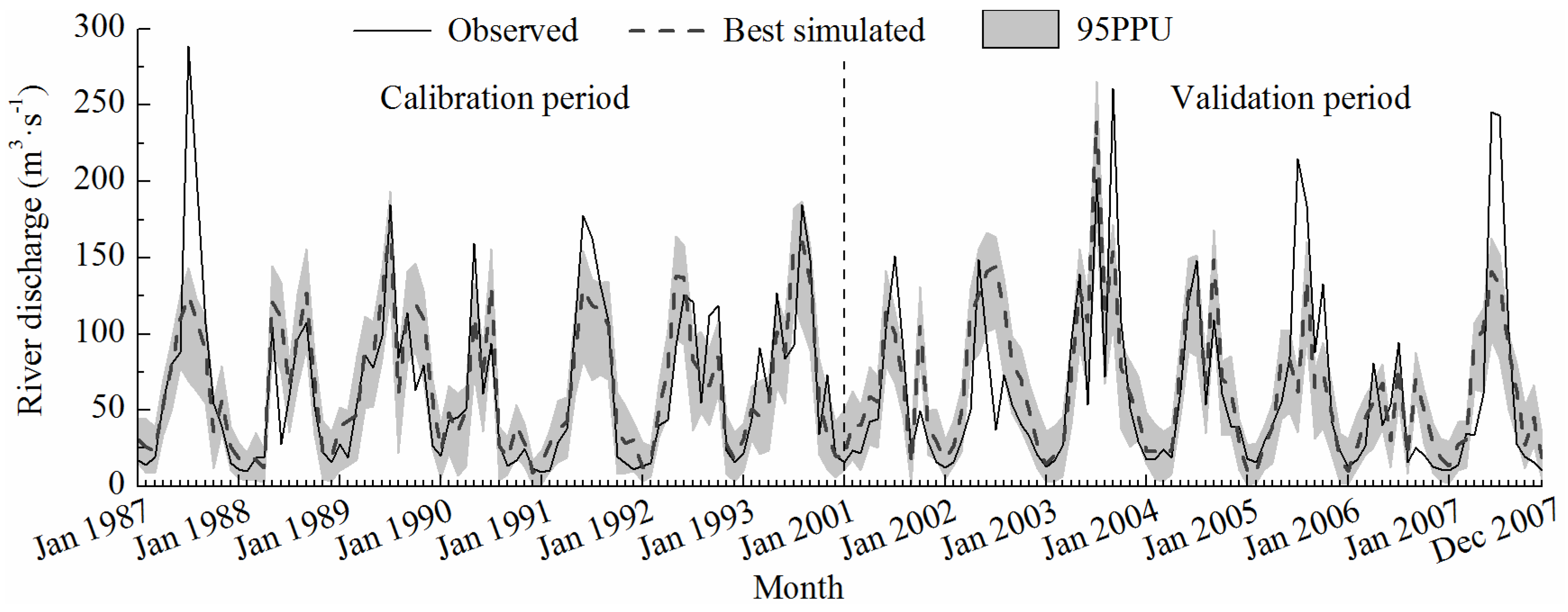Impacts of Spatial Climatic Representation on Hydrological Model Calibration and Prediction Uncertainty: A Mountainous Catchment of Three Gorges Reservoir Region, China
Abstract
:1. Introduction
2. Materials and Methods
2.1. Study Area
2.2. Data Acquisition
2.3. Model Setup and Formulation of Meteorological Inputs
2.4. Model Calibration and Uncertainty Analysis
3. Results
4. Discussion
5. Conclusions
Acknowledgments
Author Contributions
Conflicts of Interest
References
- Palmer, M.A.; Reidy Liermann, C.A.; Nilsson, C.; Flörke, M.; Alcamo, J.; Lake, P.S.; Bond, N. Climate change and the world's river basins: Anticipating management options. Front. Ecol. Environ. 2008, 6, 81–89. [Google Scholar] [CrossRef]
- Strauch, M.; Lima, J.E.F.W.; Volk, M.; Lorz, C.; Makeschin, F. The impact of best management practices on simulated streamflow and sediment load in a central brazilian catchment. J. Environ. Manag. 2013, 127, S24–S36. [Google Scholar] [CrossRef] [PubMed]
- Faramarzi, M.; Abbaspour, K.C.; Vaghefi, S.A.; Farzaneh, M.R.; Zehnder, A.J.; Srinivasan, R.; Yang, H. Modelling impacts of climate change on freshwater availability in Africa. J. Hydrol. 2013, 480, 85–101. [Google Scholar] [CrossRef]
- Du, J.; Rui, H.; Zuo, T.; Li, Q.; Zheng, D.; Chen, A.; Xu, Y.; Xu, C.Y. Hydrological simulation by swat model with fixed and varied parameterization approaches under land use change. Water Resour. Manag. 2013, 27, 2823–2838. [Google Scholar] [CrossRef]
- Wijesekara, G.; Gupta, A.; Valeo, C.; Hasbani, J.-G.; Qiao, Y.; Delaney, P.; Marceau, D. Assessing the impact of future land-use changes on hydrological processes in the elbow river watershed in southern Alberta, Canada. J. Hydrol. 2012, 412, 220–232. [Google Scholar] [CrossRef]
- Faramarzi, M.; Srinivasan, R.; Iravani, M.; Bladon, K.D.; Abbaspour, K.C.; Zehnder, A.J.; Goss, G.G. Setting up a hydrological model of Alberta: Data discrimination analyses prior to calibration. Environ. Model. Softw. 2015, 74, 48–65. [Google Scholar] [CrossRef]
- Houska, T.; Multsch, S.; Kraft, P.; Frede, H.-G.; Breuer, L. Monte Carlo-based calibration and uncertainty analysis of a coupled plant growth and hydrological model. Biogeosciences 2014, 11, 2069–2082. [Google Scholar] [CrossRef]
- Fontaine, T.; Cruickshank, T.; Arnold, J.; Hotchkiss, R. Development of a snowfall–snowmelt routine for mountainous terrain for the soil water assessment tool (swat). J. Hydrol. 2002, 262, 209–223. [Google Scholar] [CrossRef]
- Schäppi, B. Measurement and Analysis of Rainfall gradients Along a Hillslope Transect in the Swiss Alps; ETH Zurich: Zurich, Switzerland, 2013. [Google Scholar]
- Neitsch, S.L.; Arnold, J.G.; Kiniry, J.R.; Williams, J.R. Soil and Water Assessment tool, Theoretical Documentation: Version 2009; Texas Water Resources Institute, Texas A & M University System College Station: TX, USA, 2011; pp. 1–647. [Google Scholar]
- Buytaert, W.; Celleri, R.; Willems, P.; Bièvre, B.D.; Wyseure, G. Spatial and temporal rainfall variability in mountainous areas: A case study from the south Ecuadorian Andes. J. Hydrol. 2006, 329, 413–421. [Google Scholar] [CrossRef] [Green Version]
- Goovaerts, P. Geostatistical approaches for incorporating elevation into the spatial interpolation of rainfall. J. Hydrol. 2000, 228, 113–129. [Google Scholar] [CrossRef]
- Gali, R.K.; Douglas-Mankin, K.R.; Li, X.; Xu, T. Assessment of nexrad p3 data on streamflow simulation using swat model in an agricultural watershed. J. Hydrol.Eng. 2010, 17. [Google Scholar] [CrossRef]
- Cunha, L.K.; Mandapaka, P.V.; Krajewski, W.F.; Mantilla, R.; Bradley, A.A. Impact of radar-rainfall error structure on estimated flood magnitude across scales: An investigation based on a parsimonious distributed hydrological model. Water Resour. Res. 2012, 48, 1–22. [Google Scholar] [CrossRef]
- Bitew, M.M.; Gebremichael, M. Evaluation of satellite rainfall products through hydrologic simulation in a fully distributed hydrologic model. Water Resour. Res. 2011, 47, 1–11. [Google Scholar] [CrossRef]
- Bitew, M.; Gebremichael, M. Assessment of satellite rainfall products for streamflow simulation in medium watersheds of the Ethiopian highlands. Hydrol. Earth Syst. Sci. 2011, 15, 1147–1155. [Google Scholar] [CrossRef]
- Gourley, J.J.; Hong, Y.; Flamig, Z.L.; Wang, J.; Vergara, H.; Anagnostou, E.N. Hydrologic evaluation of rainfall estimates from radar, satellite, gauge, and combinations on ft. Cobb basin, Oklahoma. J. Hydrometeorol. 2011, 12, 973–988. [Google Scholar] [CrossRef]
- Kwon, S.; Jung, S.-H.; Lee, G. Inter-comparison of radar rainfall rate using constant altitude plan position indicator and hybrid surface rainfall maps. J. Hydrol. 2015, 531, 234–247. [Google Scholar] [CrossRef]
- Viviroli, D.; Zappa, M.; Gurtz, J.; Weingartner, R. An introduction to the hydrological modelling system prevah and its pre- and post-processing-tools. Environ. Model. Softw. 2009, 24, 1209–1222. [Google Scholar] [CrossRef]
- Thompson, J.; Green, A.; Kingston, D.; Gosling, S. Assessment of uncertainty in river flow projections for the Mekong river using multiple GCMs and hydrological models. J. Hydrol. 2013, 486, 1–30. [Google Scholar] [CrossRef]
- Masih, I.; Maskey, S.; Uhlenbrook, S.; Smakhtin, V. Assessing the impact of areal precipitation input on streamflow simulations using the SWAT model. J. Am. Water Resour. Assoc. 2011, 47, 179–195. [Google Scholar] [CrossRef]
- Bosshard, T.; Zappa, M. Regional parameter allocation and predictive uncertainty estimation of a rainfall-runoff model in the poorly gauged three gorges area (PR China). Phys. Chem. Earth Parts A/B/C 2008, 33, 1095–1104. [Google Scholar] [CrossRef]
- Wu, Y.J.; Gough, W.A.; Jiang, T.; Kung, H.T. The variation of floods in the middle reaches of the Yangtze river and its teleconnection with all niño events. Adv. Geosci. 2006, 6, 201–205. [Google Scholar] [CrossRef]
- Zeng, T.; Zhang, Z.; Zhao, X.; Wang, X.; Zuo, L. Evaluation of the 2010 MODIS collection 5.1 land cover type product over China. Remote Sens. 2015, 7, 1981–2006. [Google Scholar] [CrossRef]
- Soil Survey Office of Chongqing. Soil Species of Chongqing; Chongqing Soil Office Press: Chongqing, China, 1986.
- Agriculture and Animal Husbandry Department of Sichuan; Soil survey office of Sichuan. Soil Species of Sichuan; Sichuan Science & Technology Press: Chengdu, Sichuan, China, 1994.
- Saxton, K.E.; Rawls, W.J. Soil water characteristic estimates by texture and organic matter for hydrologic solutions. Soil Sci. Soc. Am. J. 2006, 70, 1569–1578. [Google Scholar] [CrossRef]
- Hargreaves, G.H.; Samani, Z.A. Reference crop evapotranspiration from temperature. Appl. Eng. Agric. 1985, 1, 96–99. [Google Scholar] [CrossRef]
- USDA Soil Conservation Service. National Engineering Handbook; Section 4, Hydrology; U.S. Department of Agriculture: Washington, DC, USA, 1972.
- Abbaspour, K.C. Swat-Cup2: Swat Calibration and Uncertainty Programs—A User Manual; Department of Systems Analysis, Swiss Federal Institute of Aquatic Science and Technology: Dübendorf, Switzerland, 2012. [Google Scholar]
- Yang, J.; Reichert, P.; Abbaspour, K.C.; Xia, J.; Yang, H. Comparing uncertainty analysis techniques for a swat application to the chaohe basin in china. J. Hydrol. 2008, 358, 1–23. [Google Scholar] [CrossRef]
- Gupta, H.V.; Bastidas, L.A.; Vrugt, J.A.; Sorooshian, S. Multiple criteria global optimization for watershed model calibration. Water Sci. Appl. 2003, 6, 125–132. [Google Scholar]
- Nash, J.E.; Sutcliffe, J.V. River flow forecasting through conceptual models part I—A discussion of principles. J. Hydrol. 1970, 10, 282–290. [Google Scholar] [CrossRef]
- Abbaspour, K.C.; Yang, J.; Maximov, I.; Siber, R.; Bogner, K.; Mieleitner, J.; Zobrist, J.; Srinivasan, R. Modelling hydrology and water quality in the pre-alpine/alpine Thur watershed using swat. J. Hydrol. 2007, 333, 413–430. [Google Scholar] [CrossRef]
- Henriksen, H.; Troldborg, L.; Højberg, A.; Refsgaard, J. Assessment of exploitable groundwater resources of Denmark by use of ensemble resource indicators and a numerical groundwater-surface water model. J. Hydrol. 2008, 348, 224–240. [Google Scholar] [CrossRef]
- Shen, Z.Y.; Hong, Q.; Yu, H.; Liu, R.M. Parameter uncertainty analysis of the non-point source pollution in the Daning river watershed of the three gorges reservoir region, china. Sci. Total Environ. 2008, 405, 195–205. [Google Scholar] [CrossRef] [PubMed]
- Leemans, R.; Cramer, W.P. The IIASA Database for Mean Monthly Values of Temperature, Precipitation, and Cloudiness on a Global Terrestrial Grid; International Institute for Applied Systems Analysis: Laxenburg, Austria, 1991. [Google Scholar]
- Martinec, J.; Rango, A. Parameter values for snowmelt runoff modelling. J. Hydrol. 1986, 84, 197–219. [Google Scholar] [CrossRef]
- Beven, K.; Freer, J. Equifinality, data assimilation, and uncertainty estimation in mechanistic modelling of complex environmental systems using the glue methodology. J. Hydrol. 2001, 249, 11–29. [Google Scholar] [CrossRef]





| Data Type | Resolution | Data source | Dataset Link |
|---|---|---|---|
| Digital elevation model | 30 × 30 m2 | Advanced Spaceborne Thermal Emission and Reflection Radiometer global, U.S. Geological Survey | http://www.usgs.gov (accessed on 5 October 2010) |
| Land use map | 30 × 30 m2 | Landsat 7 Thematic Mapper, U.S. Geological Survey | http://www.usgs.gov (accessed on 5 October 2010) |
| Soil map | 1:250,000 | Institute of Soil Science, Chinese Academy of Sciences | http://www.soil.csdb.cn (accessed on 25 November 2011) |
| Climate data | Daily | China Meteorological Administration | http://www.cma.gov.cn/2011qxfw/2011qsjgx (accessed on 1 July 2012) |
| River discharges | Daily | Bureau of Hydrology, Yangtze Water Resources Commission | http://www.cjw.gov.cn/Index.html (accessed on 5 August 2010) |
| Flow Parameter | Physical Meaning (Unit) | Relative Sensitivity | Initial Ranges | Calibrated Ranges | Best-Fit |
|---|---|---|---|---|---|
| v*_Plaps.sub | Precipitation lapse rate (mm·H2O·km−1) | −1.17 | [150, 700] | [245, 498] | 278 |
| v_Tlaps.sub | Temperature lapse rate (°C·km−1) | −0.91 | [–10, 0] | [−3.9, −0.9] | −1.3 |
| v_CH_K1.sub | Effective hydraulic conductivity in tributary channel alluvium (mm·h−1) | 0.03 | [5, 150] | [59.7, 114.3] | 82.8 |
| r**_CN2.mgt_FRST | SCS runoff curve number for moisture condition 2 of forest, agricultural land, and typical grassland | 0.61 | [−0.5, 0.5] | [−0.75, −0.17] | −0.67 |
| r_CN2.mgt_AGRL | −0.60 | [−0.5, 0.5] | [0.08, 0.65] | 0.21 | |
| r_CN2.mgt_PAST | 0.32 | [−0.5, 0.5] | [0.19, 0.68] | 0.52 | |
| v_Canmx.hru | Maximum canopy storage (mm·H2O) | −0.65 | [0, 100] | [25.6, 60] | 26.5 |
| v_ESCO.hru | Soil evaporation compensation factor | −0.36 | [0.01, 1.0] | [0.52, 0.81] | 0.78 |
| r_OV_N.hru | Manning’s “n” value for overland flow | −0.17 | [−0.5, 0.5] | [−0.43, 0.11] | −0.36 |
| r_HRU_SLP.hru | Average slope steepness (m·m−1) | −0.11 | [−0.5, 0.5] | [−0.18, 0.47] | 0.093 |
| r_SLSUBBSN.hru | Average slope length (m) | 0.07 | [−0.5, 0.5] | [−0.19, 0.11] | -0.15 |
| v_SURLAG.bsn | Surface runoff lag coefficient | 0.52 | [1, 24] | [6.3, 13.4] | 12.0 |
| v_SMFMX.bsn | Melt factor for snow on 21 June (mm·H2O/°C-day) | −1.02 | [0, 10] | [3.1, 6.7] | 4.92 |
| v_TIMP.bsn | Snow pack temperature lag factor | −0.79 | [0, 1] | [0.49, 1] | 0.59 |
| v_SNO50COV.bsn | Ratio of snow water equivalent at 50% areal snow coverage to its threshold at 100% snow cover | −3.41 | [0, 1] | [0.18, 0.56] | 0.49 |
| v_CH_K2.rte | Effective hydraulic conductivity in main channel alluvium (mm·h−1) | −1.28 | [0, 150] | [0, 58.6] | 28.0 |
| v_CH_N2.rte | Manning’s “n” value for the main channel | 1.00 | [0, 0.2] | [0.028, 0.11] | 0.086 |
| r_Sol_K(1).sol | Saturated hydraulic conductivity (mm·h−1) | −0.26 | [−0.5, 0.5] | [0.2, 0.76] | 0.63 |
| r_Sol_AWC(1).sol | Available water capacity of the soil layer (mm·H2O·mm−1 soil) | −0.05 | [−0.5, 0.5] | [0.16, 0.69] | 0.63 |
| v_GWQMN.gw | Threshold depth of water in the shallow aquifer required for return flow to occur (mm·H2O) | 1.70 | [0, 5000] | [520,2010] | 984.1 |
| v_GW_REVAP.gw | Groundwater “revap” coefficient | −2.37 | [0. 0, 0.2] | [0.04, 0.2] | 0.10 |
| v_GW_DELAY.gw | Groundwater delay time (days) | −1.00 | [0, 500] | [8.33, 212.8] | 124 |
| Year | Fd (%) | Fd Performance | Year | Fd (%) | Fd Performance |
|---|---|---|---|---|---|
| 1987 | −21.5 * | poor | 2001 | 12.4 | Fair |
| 1988 | 26.4 | poor | 2002 | 45.3 | very poor |
| 1989 | 15.8 | fair | 2003 | −6.7 * | very good |
| 1990 | 5.3 | very good | 2004 | 6.4 | very good |
| 1991 | −2.8 * | excellent | 2005 | −32.1 * | Poor |
| 1992 | 2.44 | excellent | 2006 | 25.0 | Poor |
| 1993 | -3.1 * | excellent | 2007 | –5.1 * | very good |
| Performance Indicator | Excellent | Very Good | Fair | Poor | Very Poor |
| NSE | >0.85 | 0.65–0.85 | 0.50–0.65 | 0.20–0.50 | <0.20 |
| Fd | <5% | 5%–10% | 10%–20% | 20%–40% | >40% |
| Period | Procedure | Goodness-of-Fit Measures | “Without” Model Setup | “With” Model Setup |
|---|---|---|---|---|
| 1987–1993 | Prior calibration (daily) | NSE | 0.25 | 0.36 |
| 1st and 2nd Iteration (daily) | NSE | 0.29 (1st), 0.33 (2nd) | 0.42 (1st), 0.45 (2nd) | |
| P-factor (%) | 55 (1st), 66 (2nd) | 77 (1st), 80 (2nd) | ||
| R-factor | 0.39 (1st), 0.37 (2nd) | 0.66 (1st), 0.61 (2nd) | ||
| Calibration (monthly) | NSE | 0.47 | 0.69 | |
| P-factor (%) | 49 | 85 | ||
| R-factor | 0.46 | 0.87 | ||
| 2001–2007 | Validation (monthly) | NSE | 0.42 | 0.59 |
| P-factor (%) | 26 | 75 | ||
| R-factor | 0.13 | 0.76 |
© 2016 by the authors; licensee MDPI, Basel, Switzerland. This article is an open access article distributed under the terms and conditions of the Creative Commons by Attribution (CC-BY) license (http://creativecommons.org/licenses/by/4.0/).
Share and Cite
Li, Y.; Thompson, J.R.; Li, H. Impacts of Spatial Climatic Representation on Hydrological Model Calibration and Prediction Uncertainty: A Mountainous Catchment of Three Gorges Reservoir Region, China. Water 2016, 8, 73. https://doi.org/10.3390/w8030073
Li Y, Thompson JR, Li H. Impacts of Spatial Climatic Representation on Hydrological Model Calibration and Prediction Uncertainty: A Mountainous Catchment of Three Gorges Reservoir Region, China. Water. 2016; 8(3):73. https://doi.org/10.3390/w8030073
Chicago/Turabian StyleLi, Yan, Julian R. Thompson, and Hengpeng Li. 2016. "Impacts of Spatial Climatic Representation on Hydrological Model Calibration and Prediction Uncertainty: A Mountainous Catchment of Three Gorges Reservoir Region, China" Water 8, no. 3: 73. https://doi.org/10.3390/w8030073






